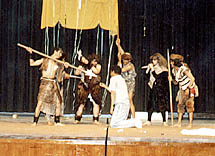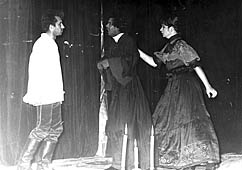
Contemporary Yemeni Theater [Archives:1998/32/Culture]
August 10 1998
Students Started It:
In his extensive study “Seventy Years of Theater in Yemen”, Saeed Awlaqi indicates that the first acting in Yemen was in 1904. An Indian troupe, headed by Jomlat Khan, came to Aden to entertain the Indian community. In the process, they enlisted the services of some locals. That, of course, was not the real beginning of the theater in Yemen in the professional sense. Even the language was not local. But the event triggered more developments.

At the beginning, Yemeni theater was dependent on translated foreign plays, especially Indian and English. But later on, Arabic historical novels were adapted for the theater, again by troupes from various schools. The first such play – “Salah Al-Din Al-Ayubi” – was performed in 1929.
Thus, it is clear that acting in modern Yemen was born in Adeni schools, to which the beginnings of contemporary Yemeni theater can be traced.
Non-political Themes:
Soon, acting became an important part of the entertainment world of Aden. But, themes were almost always non-political.

Also, they took an interest in historical folk tales and novels such as “Antra Bin Shadad” and “Abu Zeid Al-Hilali.” In Seventy Years of Theater in Yemen, Mr. Awlaqi traces the history of modern theater, mainly in the Southern governorates. The school theater, which used to show some historical drama, flourished towards the end of the 1950s especially when political ideas had been dealt with in some dramas.
Poetry Plays
The first dramatic work in Yemen was a poetry play called “Pygmalion,” a Yemenized version of the famous play adapted by the poet Mohammed Ali Luqman in 1948. Also, another poetry play was written by Mohammed Ali Luqman called “Samra Al-Arab” (the Brunette Woman of the Arabs), in 1966.
Many poetry plays were written at that time. Seven were written by Mohammed Al-Sharafi, five by Mohammed Abdu Ghanem and one poet Abdulrahim Al-Qirshi.
By far, the most popular plays were “Samra Al-Arab” of 1948, “Ardh al-Jannatain,” (Land of 2 Paradises), written in 1963, “Saif Bin Dhi Yazan” written in 1964, and “Hariq fi Sanaa” (Fire in Sanaa) written in 1974.
Those four plays were major landmarks in the development of Yemeni theater.
Samra’a Al-Arab: In June 1948, Ali Luqman published his Yemenized version of Bernard Shaw’s Pygmalion. In June 1966, he published his drama “Samra’a Al-Arab,” exactly 18 years after publishing “Pygmalion.” The latter seems to be better in terms of poetry and performances.
Being influenced by the struggle against the British forces, Luqman wrote “Samra’a Al-Arab,” a political drama full of national symbols. Although the drama was written about Tadmor and the Roman Empire in the third century AD, everybody knew that Tadmor actually represents “Aden” and the Roman Empire represents the British colonial forces.
Khairan, the Arabic ruler and traitor in the drama, is a dramatic creation embodying all the collaborators who served the British forces. Luqman talked a great deal about the political conflict inside Tadmor between the Romans and the Persians who were planning to conquer the city. The same was going on in Aden, when Luqman was set to write “Samra’a Al-Arab.”
The drama’s fervently nationalistic poetry added fuel to the revolution against colonialism. This was its real message.
Fi Ardh Al-Jannatain (Land of Two Paradises) is a long four-act play. It deals with the tyranny of Imam Ahmed, his brutal revenge on the revolutionaries from 1948 until 1955, the uprising of 1955, the assassination of the Imam, the nationalists such as Al-Thulaya, Al-Luqayya and Al-Olufi.
Saif Bin Dhi Yazan’s first act deals with some aspects of the Najran events. At the end of the act, the Abyssinians sought revenge for fellow Christians. But the Yemeni king Du Nawas fought ferociously. When he lost, he jumped into the sea and drowned.
In the second act, Saif Bin Dhi Yazan was captured by the enemies when he fell unconscious in battle. The third act shows the preparations made by the Abyssinians for invading Mecca. The fourth act is about the journey of Saif to Persia to meet its ruler, and his return journey to Yemen with an army to achieve his victory over the Abyssinians.
This play lacks the symbolism which could have given it some richness. However, Shams – the play’s heroine could be the symbol of Yemen. Saif Bin Di Yazan loved Shams and asked the help of Persia to free her from Abyssinian bondage. The traitor Hassan was also fond of Shams and tried to win her by siding with the invaders.
Also, the Abyssinian leaders Irbat and Abraha adored Shams, but she only wanted Saif as her redeemer.
Hariq fi Sanaa (Fire in Sanaa) consists of three acts and two scenes. Its main theme is the fire which broke out in a cinema house during a drought and famine period. The uneducated people of Sanaa believed that this natural disaster which hit Yemen came as a result of the films shown at the cinema. They forgot that Yemen had been afflicted with many such disasters during the reign of the Imam even before the cinema came into being.
The theme is rich and vital. The microbe symbolizes the fire. However, the writer used the modern free verse, which disconnected this dramatic structure.
Today, the modern Yemen continues to witness important plays establishing this profession in the country’s culture in a solid way. Acting is improving day by day. In 1971, the National Theater Group was established. Another group was established in 1973. These groups and many others performed many local, Arabic and even translated works. They also presented many serials and stories for television and radio programs.
By: Farid Al-Dhahiry,
Actor/Director
——
[archive-e:32-v:1998-y:1998-d:1998-08-10-p:./1998/iss32/culture.htm]


